The Complex Effect of Different Tillage Systems on the Faba Bean Agroecosystem
Abstract
:1. Introduction
2. Materials and Methods
2.1. Site Description
2.2. Experimental Design and Agricultural Practice
2.3. Methodology
2.3.1. Methods and Analysis
2.3.2. Statistical Analysis and Calculations
3. Results and Discussion
3.1. Level 1: Soil Aggregate Stability
3.2. Level 2: CO2 Emission
3.3. Level 3: Faba Bean Crop Density
3.4. Level 4: Faba Bean Canopy Biomass
3.5. Level 5: Yield of Faba Bean Seeds
3.6. Level 6: Weed Density
3.7. Level 7: Air-Dried Weed Biomass
4. Conclusions
Supplementary Materials
Author Contributions
Funding
Data Availability Statement
Conflicts of Interest
References
- Gao, B.; Bian, X.C.; Yang, F.; Chen, M.X.; Das, D.; Zhu, X.R.; Jiang, Y.; Zhang, J.; Cao, Y.Y.; Wu, C.F. Comprehensive transcriptome analysis of faba bean in response to vernalization. Plant 2020, 251, 10–22. [Google Scholar] [CrossRef]
- Guo, Z.; Dong, Y.; Dong, K.; Zhu, J.; Ma, L. Effects of nitrogen management and intercropping on faba bean chocolate spot disease development. J. Crop Prot. 2020, 127, 104972. [Google Scholar] [CrossRef]
- Boldrinin, A.; Benincasa, P.; Tosti, G.; Tei, F.; Guiducci, M. The Risk of N Loss in an Organic and a Conventional Farming System; Editorial Milenio: Lleida, Spain, 2007; pp. 315–317. [Google Scholar]
- Statistics Lithuania. Official Statistics Portal: Agriculture. 2023. Available online: https://osp.stat.gov.lt/en_GB/zemes-ukis1 (accessed on 20 December 2023).
- Bond, D.A.; Jellis, G.J.; Rowland, G.G.; Le Guen, J.; Robertson, L.D.; Khalil, S.A.; Li-Juan, L. Present status and future strategy in breeding faba beans (Vicia faba L.) for resistance to biotic and abiotic stresses. Euphytica 1994, 73, 151–166. [Google Scholar] [CrossRef]
- Xia, M.Z. Effects of drought during the generative development phase of faba bean (Vicia faba L.) on photosynthetic characters and biomass production. J. Agric. Sci. 1994, 122, 67–72. [Google Scholar] [CrossRef]
- Girma, F.; Haile, D. Effects of supplemental irrigation on physiological parameters and yield of faba bean (Vicia faba L.) varieties in the highlands of Bale, Ethiopia. Agronomy 2014, 13, 29–34. [Google Scholar] [CrossRef]
- Etemadi, F.; Hashemi, M.; Barker, A.V.; Zandvakili, O.R.; Liu, X. Agronomy, Nutritional Value, and Medicinal Application of Faba Bean (Vicia faba L.). Hortic. Plant J. 2019, 5, 170–182. [Google Scholar] [CrossRef]
- Munoz-Romero, V.; López-Bellido, L.; López-Bellido, R.J. Faba bean root growth in a Vertisol: Tillage effects. Field Crops Res. 2011, 120, 338–344. [Google Scholar] [CrossRef]
- Paris, B.; Vandorou, F.; Balafoutis, A.T.; Vaiopoulos, K.; Kyriakarakos, G.; Ma-Nolakos, D.; Papadakis, G. Energy use in open-field agriculture in the EU: A critical review recommending energy efficiency measures and renewable energy sources adoption. Renew. Sust. Energ. Rev. 2022, 158, 112098. [Google Scholar] [CrossRef]
- Paul, E.A.; Clark, F.E. Soil Microbiology and Biochemistry; Academic Press: San Diego, CA, USA, 1989; 273p. [Google Scholar]
- Siddique, K.H.M.; Brinsmead, R.B.; Knight, R.; Knights, E.J.; Paull, J.G.; Roses, I.A. Adaptation of chickpea (Cicer arietinum L.) and faba bean (Vicia faba L.) to Australia. Plant Sci. Biotechnol. Agric. 2000, 34, 889–891. [Google Scholar]
- Kryzevičius, Z.; Karčiauskienė, D.; Álvarez-Rodríguez, E.; Žukauskaitė, A.; Šlepetienė, A.; Volungevičius, J. The effect of over 50 years of liming on soil aluminium forms in a Retisol. J. Agric. Sci. 2019, 157, 12–19. [Google Scholar] [CrossRef]
- Kulig, B.; Lepiarczyk, A.; Oleksy, A.; Kolodziejczyk, M. The effect of tillage system and forecrop on the yield and values of LAI and SPAD indices of spring wheat. Eur. J. Agron. 2010, 33, 43–51. [Google Scholar] [CrossRef]
- Zhang, D.; Zhang, C.; Tang, X.; Li, H.; Zhang, F.; Rengel, Z.; Whalley, W.R.; Davies, W.J.; Shen, J. Increased soil phosphorus availability induced by faba bean root exudation stimulates root growth and phosphorus uptake in neighbouring maize. New Phytol. 2015, 209, 823–831. [Google Scholar] [CrossRef]
- Romaneckas, K.; Adamavičienė, A.; Šarauskis, E.; Kriaučiūnienė, Z.; Marks, M.; Vaitauskienė, K. Impact of living mulches on the physical properties of Planosol in monocropped maize agroecosystem. Int. Agrophys. 2018, 32, 165–173. [Google Scholar] [CrossRef]
- Organisation for Cooperation and Economic Development (OECD). AEI Methods and Results; OECD: Paris, France, 2013; Volume 3, pp. 389–391. [Google Scholar]
- Sandén, T.; Trajanov, A.; Spiegel, H.; Kuzmanovski, V.; Saby, N.; Picaud, C.; Henriksen, C.B.; Debeljak, M. Development of an agricultural primary productivity decision support model: A case study in France. Front. Environ. Sci. 2019, 7, 1–13. [Google Scholar] [CrossRef]
- Li, Y.; Song, D.; Liang, S.; Dang, P.; Qin, X.; Liao, Y.; Siddique, K.H. Effect of no-tillage on soil bacterial and fungal community diversity: A meta-analysis. Soil Tillage Res. 2020, 204, 104721. [Google Scholar] [CrossRef]
- Romaneckas, K.; Kimbirauskienė, R.; Adamavičienė, A.; Buragienė, S.; Sinkevičienė, A.; Šarauskis, E.; Jasinskas, A.; Minajeva, A. Impact of sustainable tillage on biophysical properties of Planosol and on faba bean yield. Agric. Food Sci. 2019, 28, 101–111. [Google Scholar] [CrossRef]
- Romaneckas, K.; Kimbirauskienė, R.; Sinkevičienė, A.; Jaskulska, I.; Buragienė, S.; Adamavičienė, A.; Šarauskis, E. Weed Diversity, Abundance, and Seedbank in Differently Tilled Faba Bean (Vicia faba L.) Agroecosystems. Agronomy 2021, 11, 529. [Google Scholar] [CrossRef]
- Hofmann, E.; Seegerer, A. Der Fermentgehalt des Bodens als Maßstab seiner biologischen Aktivität. Biochem. Z. 1950, 321, 97. (In German) [Google Scholar]
- Chunderova, A. Enzymatic Activity of Gleyic Soils in North-West Zone. Ph.D. Dissertation, Tallinn University, Tallinn, Estonia, 1973. (In Russian). [Google Scholar]
- Stancevičius, A. Piktžolių Apskaita ir Laukų Piktžolėtumo Kartografavimas/Weed Accounting and Field Weediness Mapping; Mokslas: Vilnius, Lithuania, 1979; 37p. (In Lithuanian) [Google Scholar]
- Lohmann, G. Entwicklung Eines Bewertungsverfahrens für Anbausysteme mit Differenzierten Aufwandmengen Ertragssteigernder und Ertragssichernder Betriebsmittel. Dissertation, Institut für Pflanzenbau der Rheinischen Friedrich-Wilhelms-Universität Bonn, Bonn, Germany, 1994. (In German). [Google Scholar]
- Heyland, K.U. Zur methodik einer integrierten darstellung und bewertung der produktionsverfahren im pflanzenbau. Pflanzenbauwissenschaften 1998, 2, 145–159. (In German) [Google Scholar]
- Rudinskienė, A. Caraway (Carum carvi L.) in Multifunctional Crops Agroecosystems and Their Impact on the Agroecosystem. Ph.D. Thesis, Vytautas Magnus University, Kaunas-Akademija, Lithuania, 2022. [Google Scholar]
- Schulte, R.P.; Creamer, R.E.; Donnellan, T.; Farrelly, N.; Fealy, R.; O’Donoghue, C.; O’huallachain, D. Functional land management: A framework for managing soil-based ecosystem services for the sustainable intensification of agriculture. Environ. Sci. Policy 2014, 38, 45–58. [Google Scholar] [CrossRef]
- Moebius-Clune, B.N. Comprehensive Assessment of Soil Health: The Cornell Framework Manual; Cornell University: Ithaca, NY, USA, 2016. [Google Scholar]
- Crittenden, S.J.; Poot, N.; Heinen, M.D.J.M.; Van Balen, D.J.M.; Pulleman, M.M. Soil physical quality in contrasting tillage systems in organic and conventional farming. Soil Tillage Res. 2015, 154, 136–144. [Google Scholar] [CrossRef]
- Moraes, M.T.; Debiasi, H.; Carlesso, R.; Franchini, J.C.; da Silva, V.R.; da Luz, F.B. Soil physical quality on tillage and cropping systems after two decades in the subtropical region of Brazil. Soil Tillage Res. 2016, 155, 351–362. [Google Scholar] [CrossRef]
- Parvin, N.; Coucheney, E.; Gren, M.; Andersson, H.; Elofsson, K.; Jarvis, N.; Keller, T. On the relationships between the size of agricultural machinery, soil quality and net revenues for farmers and society. Soil Sci. 2022, 6, 100044. [Google Scholar]
- Acar, M.; Celik, I.; Günal, H.; Acir, N.; Barut Bereket, Z.; Budak, M. Tillage effects on soil organic carbon, microbial biomass carbon and beta-glucosidase enzyme activity in a typic haploxerert soil. Sci. Papers Ser. A Agron. 2018, 61, 13–20. [Google Scholar]
- Sae-Tun, O.; Bodner, G.; Rosinger, C.; Zechmeister-Boltenstern, S.; Mentler, A.; Keiblinger, K. Fungal biomass and microbial necromass facilitate soil carbon sequestration and aggregate stability under different soil tillage intensities. Appl. Soil Ecol. 2022, 179, 104599. [Google Scholar] [CrossRef]
- Celik, I.; Günal, H.; Acir, N.; Barut, Z.B.; Budak, M. Soil quality assessment to compare tillage systems in Cukurova Plain, Turkey. Soil Tillage Res. 2021, 208, 104892. [Google Scholar] [CrossRef]
- Sinkevičius, A. Long-Term Effects of Soil Tillage Technologies on the Sustainability of Agroecosystems. Ph.D. Thesis, Vytautas Magnus University, Kaunas-Akademija, Lithuania, 2023. [Google Scholar]
- Noh, N.J.; Son, Y.; Lee, S.K.; Yoon, T.K.; Seo, K.W.; Kim, C.; Lee, W.K.; Bae, S.W.; Hwang, J. Influence of stand density on soil CO2 efflux for a Pinus densiflora forest in Korea. J. Plant Res. 2010, 123, 411–419. [Google Scholar] [CrossRef]
- Nunes, M.R.; Karlen, D.L.; Denardin, J.E.; Cambardella, C.A. Corn root and soil health indicator response to no-till production practices. Agric. Ecosyst. Environ. 2019, 285, 106607. [Google Scholar] [CrossRef]
- Sinkevičienė, A. The Effect of Organic Mulches on Soil Properties, Seget Flora and Plant Productivity. Ph.D. Thesis, Vytautas Magnus University, Kaunas-Akademija, Lithuania, 2011. [Google Scholar]


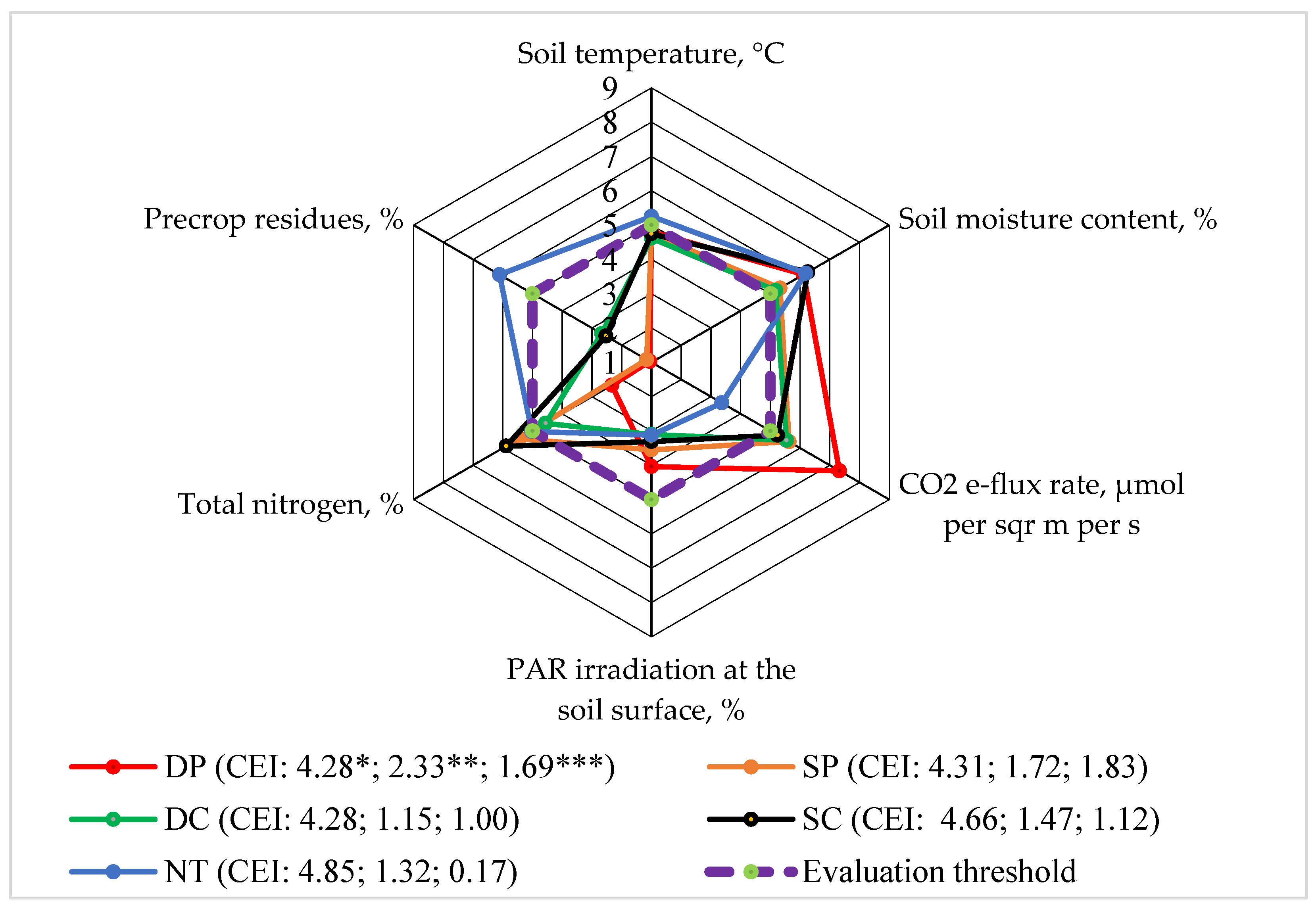
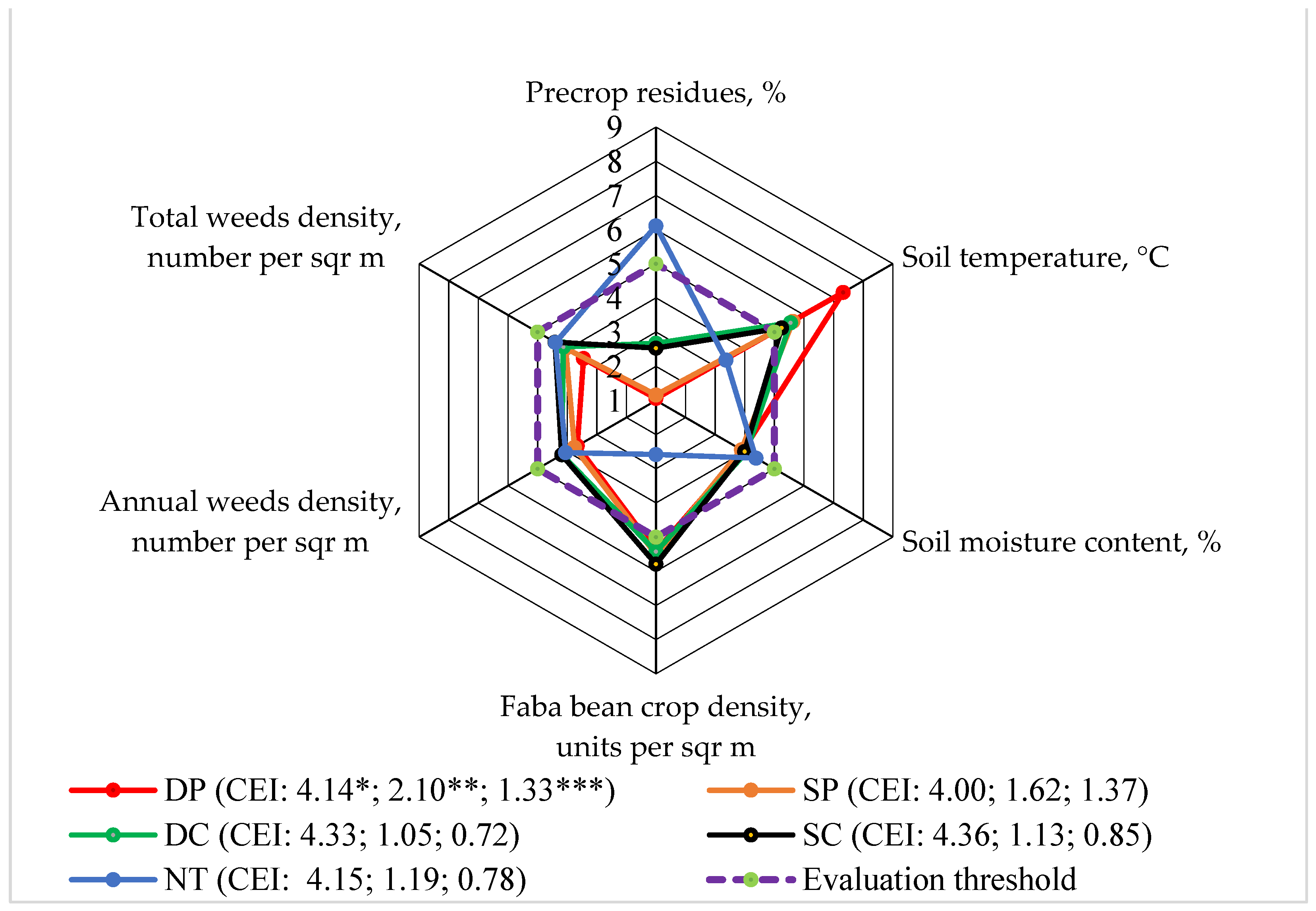
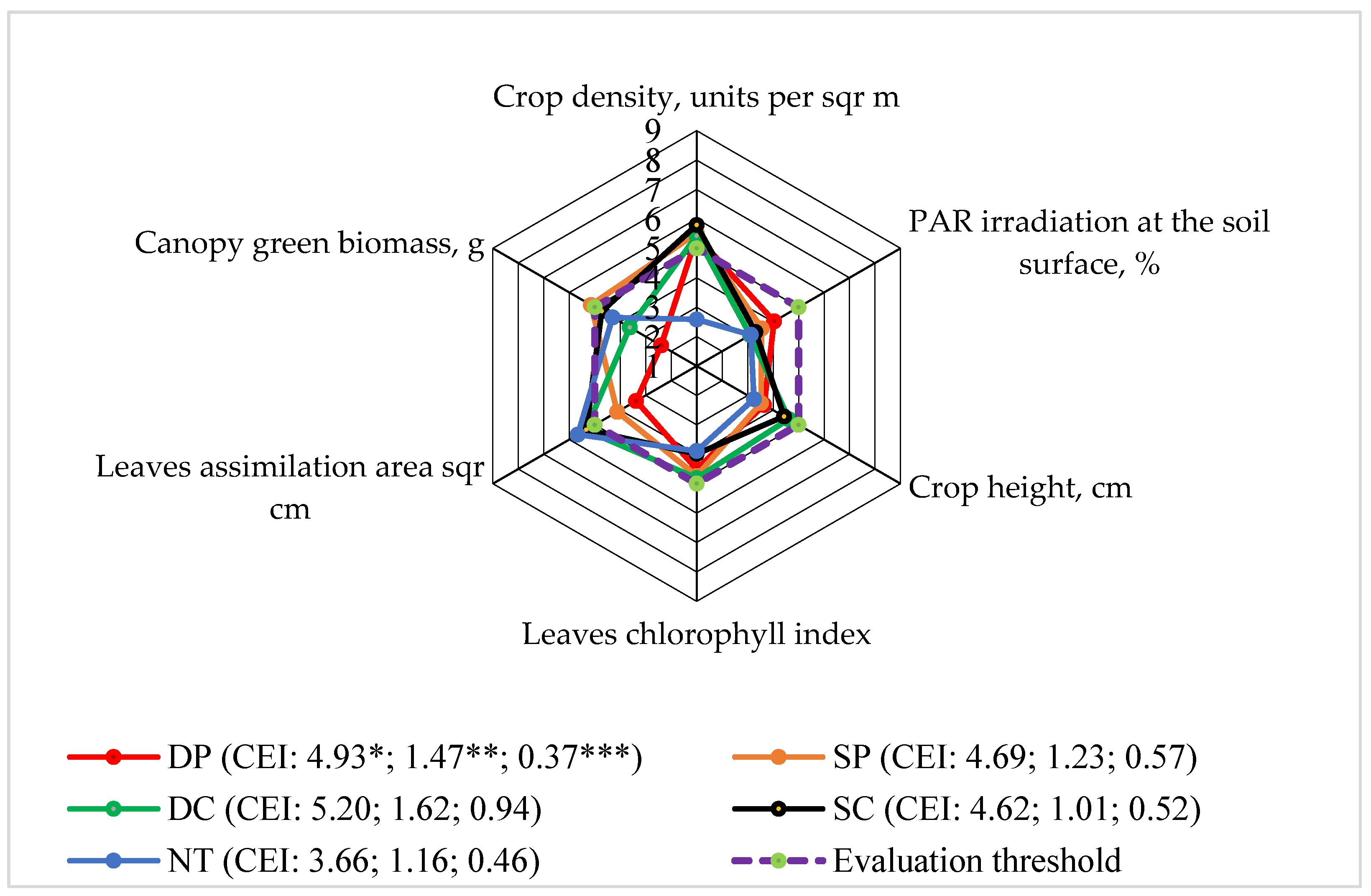
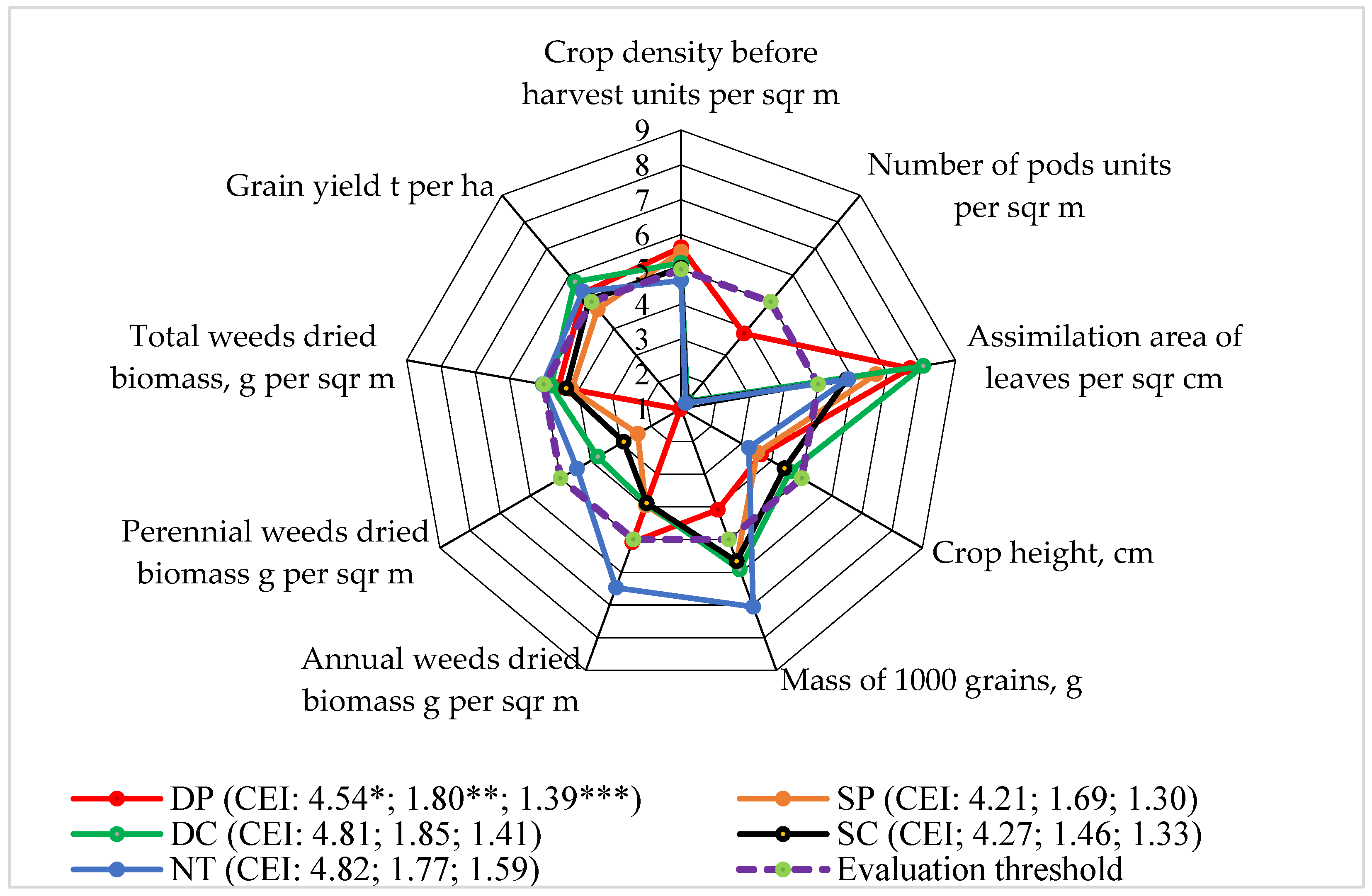
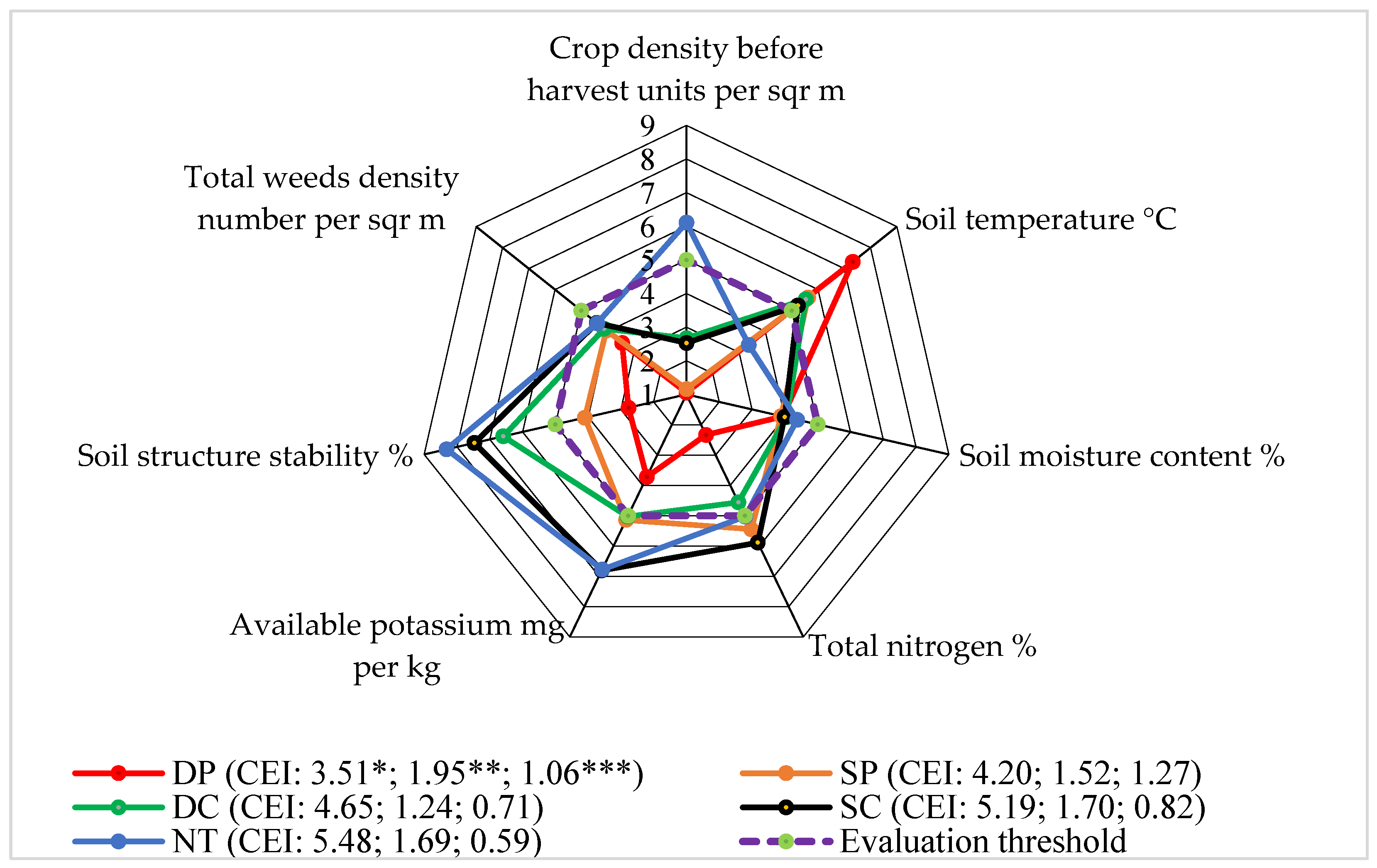

| Month/Year | 2016 | 2017 | 2018 | Long-Term Average |
|---|---|---|---|---|
| April | 7.4 | 5.6 | 10.2 | 6.9 |
| May | 15.7 | 12.9 | 17.2 | 13.2 |
| June | 17.2 | 15.4 | 17.5 | 16.1 |
| July | 17.9 | 16.8 | 20.1 | 18.7 |
| August | 16.9 | 17.5 | 19.2 | 17.3 |
| September | - | 13.4 | - | 12.6 |
| Month/Year | 2016 | 2017 | 2018 | Long-Term Average |
|---|---|---|---|---|
| April | 41.2 | 73.7 | 64.8 | 41.3 |
| May | 36.4 | 10.2 | 17.6 | 61.7 |
| June | 83.9 | 80.2 | 57.6 | 76.9 |
| July | 162.9 | 79.6 | 137.5 | 96.6 |
| August | 114.9 | 55.0 | 66.2 | 88.9 |
| September | - | 87.1 | - | 60.0 |
| Tillage System | Stubble Tillage | Primary Tillage | Implement | Depth of Tillage cm | Pre-Crop Residue Cover % |
|---|---|---|---|---|---|
| Deep ploughing | Yes | Inversion | Moldboard plough | 22–25 | 0–3 |
| Shallow ploughing | Yes | Inversion | Moldboard plough | 12–15 | 2–4 |
| Deep cultivation | Yes | Non-inversion | Chisel cultivator | 25–30 | 40–51 |
| Shallow cultivation | Yes, twice | Non-inversion | Disc harrow | 10–12 | 40–50 |
| No-tillage | No | No | None | 0 | 47–87 |
| Indices | Variation | Units | Indices | Variation | Units |
|---|---|---|---|---|---|
| Pre-crop residues | 0.3–82.8 | % | PAR at the soil surface | 0.5–23.6 | % |
| Soil aggregate stability (at the beginning of vegetative season) | 35.9–72.7 | % | Crop height in the middle of vegetative season | 50.1–101.0 | cm |
| Total nitrogen (at the beginning of vegetative season) | 0.11–0.17 | % | Leaf chlorophyll index | 23.20–47.0 | – |
| Available potassium (at the beginning of vegetative season) | 85.0–181.0 | mg kg–1 | Leaf assimilation area | 337.20–1270.9 | cm2 |
| Earthworm biomass | 23.5–134.7 | g m–2 | Faba bean plant average canopy green biomass | 45.40–106.30 | g |
| Saccharase activity | 19.7–50.0 | mg glucoses 1 g of soil per 48 h | Total weed density (at the beginning of vegetative season) | 25.0–246.20 | number m–2 |
| Soil temperature (at the beginning of vegetative season) | 18.8–21.5 | °C | Total weed density (at the end of vegetative season) | 18.8–80.8 | number m–2 |
| Soil moisture content (at the beginning of vegetative season) | 11.3–16.2 | % | Total weed biomass (at the end of vegetative season) | 30.8–219.2 | g m–2 |
| Soil temperature (in the middle of vegetative season) | 14.7–18.9 | °C | Number of pods | 207.6–522.0 | m2 |
| Soil moisture content (in the middle of vegetative season) | 15.0–18.7 | % | Mass of 1000 grains | 483.70–610.17 | g |
| CO2 e–flux rate (in the middle of vegetative season) | 3.07–7.66 | µmol m–2 s–1 | Grain yield | 2.19–5.92 | t ha–1 |
| Early faba bean crop density | 19.9–46.0 | units m–2 | Canopy dried biomass at harvest | 6.56–12.81 | t ha–1 |
| Crop density before harvest | 32.4–55.6 | units m–2 |
Disclaimer/Publisher’s Note: The statements, opinions and data contained in all publications are solely those of the individual author(s) and contributor(s) and not of MDPI and/or the editor(s). MDPI and/or the editor(s) disclaim responsibility for any injury to people or property resulting from any ideas, methods, instructions or products referred to in the content. |
© 2024 by the authors. Licensee MDPI, Basel, Switzerland. This article is an open access article distributed under the terms and conditions of the Creative Commons Attribution (CC BY) license (https://creativecommons.org/licenses/by/4.0/).
Share and Cite
Kimbirauskienė, R.; Sinkevičienė, A.; Švereikaitė, A.; Romaneckas, K. The Complex Effect of Different Tillage Systems on the Faba Bean Agroecosystem. Plants 2024, 13, 513. https://doi.org/10.3390/plants13040513
Kimbirauskienė R, Sinkevičienė A, Švereikaitė A, Romaneckas K. The Complex Effect of Different Tillage Systems on the Faba Bean Agroecosystem. Plants. 2024; 13(4):513. https://doi.org/10.3390/plants13040513
Chicago/Turabian StyleKimbirauskienė, Rasa, Aušra Sinkevičienė, Austėja Švereikaitė, and Kęstutis Romaneckas. 2024. "The Complex Effect of Different Tillage Systems on the Faba Bean Agroecosystem" Plants 13, no. 4: 513. https://doi.org/10.3390/plants13040513
APA StyleKimbirauskienė, R., Sinkevičienė, A., Švereikaitė, A., & Romaneckas, K. (2024). The Complex Effect of Different Tillage Systems on the Faba Bean Agroecosystem. Plants, 13(4), 513. https://doi.org/10.3390/plants13040513









